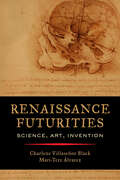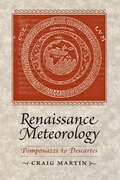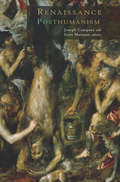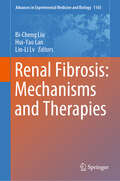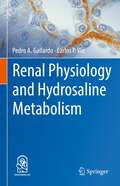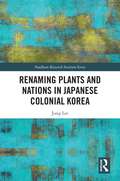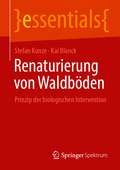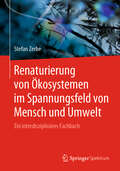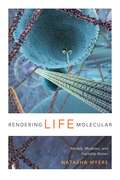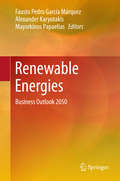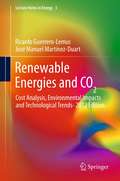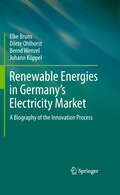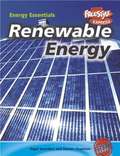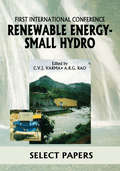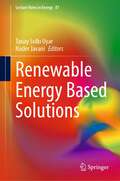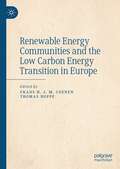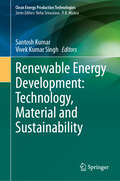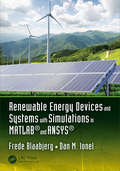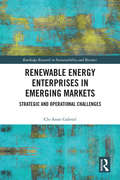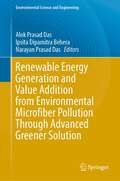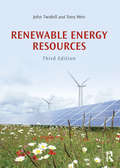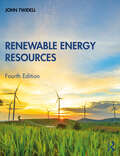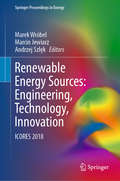- Table View
- List View
Removing Mountains: Extracting Nature and Identity in the Appalachian Coalfields (A Quadrant Book)
by Rebecca R. ScottA coal mining technique practiced in southern West Virginia known as mountaintop removal is drastically altering the terrain of the Appalachian Mountains. Peaks are flattened and valleys are filled as the coal industry levels thousands of acres of forest to access the coal, in the process turning the forest into scrubby shrublands and poisoning the water. This is dangerous and environmentally devastating work, but as Rebecca R. Scott shows in Removing Mountains, the issues at play are vastly complicated.In this rich ethnography of life in Appalachia, Scott examines mountaintop removal in light of controversy and protests from environmental groups calling for its abolishment. But Removing Mountains takes the conversation in a new direction, telling the stories of the businesspeople, miners, and families who believe they depend on the industry to survive. Scott reveals these southern Appalachian coalfields as a meaningful landscape where everyday practices and representations help shape a community's relationship to the environment.Removing Mountains demonstrates that the paradox that faces this community-forced to destroy their land to make a wage-raises important questions related not only to the environment but also to American national identity, place, and white working-class masculinity.
Renaissance Futurities: Science, Art, Invention
by Charlene Villaseñor Black and Mari-Tere ÁlvarezAt publication date, a free ebook version of this title will be available through Luminos, University of California Press’s Open Access publishing program. Visit www.luminosoa.org to learn more.Renaissance Futurities considers the intersections between artistic rebirth, the new science, and European imperialism in the global early modern world. Charlene Villaseñor Black and Mari-Tere Álvarez take as inspiration the work of Renaissance genius Leonardo da Vinci (1452–1519), prolific artist and inventor, and other polymaths such as philosopher Giulio "Delminio" Camillo (1480–1544), physician and naturalist Francisco Hernández de Toledo (1514–1587), and writer Miguel de Cervantes (1547–1616). This concern with futurity is inspired by the Renaissance itself, a period defined by visions of the future, as well as by recent theorizing of temporality in Renaissance and Queer Studies. This transdisciplinary volume is at the cutting edge of the humanities, medical humanities, scientific discovery, and avant-garde artistic expression.
Renaissance Meteorology: Pomponazzi to Descartes
by Craig MartinCraig Martin takes a careful look at how Renaissance scientists analyzed and interpreted rain, wind, and other natural phenomena like meteors and earthquakes and their impact on the great thinkers of the scientific revolution.Martin argues that meteorology was crucial to the transformation that took place in science during the early modern period. By examining the conceptual foundations of the subject, Martin links Aristotelian meteorology with the new natural philosophies of the seventeenth century. He argues that because meteorology involved conjecture and observation and forced attention to material and efficient causation, it paralleled developments in the natural philosophies of Descartes and other key figures of the scientific revolution. Although an inherently uncertain endeavor, forecasting the weather was an extremely useful component not just of scientific study, but also of politics, courtly life, and religious doctrine. Martin explores how natural philosophers of the time participated in political and religious controversies by debating the meanings, causes, and purposes of natural disasters and other weather phenomena. Through careful readings of an impressive range of texts, Martin situates the history of meteorology within the larger context of Renaissance and early modern science. The first study on Renaissance theories of weather in five decades, Renaissance Meteorology offers a novel understanding of traditional natural philosophy and its impact on the development of modern science.
Renaissance Posthumanism
by Joseph Campana and Scott MaisanoConnecting Renaissance humanism to the variety of “critical posthumanisms” in twenty-first-century literary and cultural theory, Renaissance Posthumanism reconsiders traditional languages of humanism and the human, not by nostalgically enshrining or triumphantly superseding humanisms past but rather by revisiting and interrogating them. What if today’s “critical posthumanisms,” even as they distance themselves from the iconic representations of the Renaissance, are in fact moving ever closer to ideas in works from the fourteenth to the seventeenth century? What if “the human” is at once embedded and embodied in, evolving with, and de-centered amid a weird tangle of animals, environments, and vital materiality? Seeking those patterns of thought and practice, contributors to this collection focus on moments wherein Renaissance humanism looks retrospectively like an uncanny “contemporary”—and ally—of twenty-first-century critical posthumanism.
Renal Disease in Pregnancy
by Philip Baker Sean Kehoe John M Davison Catherine Nelson-PiercyThis book explores the most up-to-date evidence on all aspects of diagnosis and management in women with renal problems before, during and after pregnancy. The chapters describe many of the issues likely to be faced in clinical practice, providing valuable information for all healthcare professionals working in this field. The text stems from the 54th RCOG Study Group on renal disease in pregnancy, which allowed specialists in many disciplines to sift the most up-to-date evidence on all aspects of diagnosis and management in women with renal problems before, during and after pregnancy. The chapters describe many of the issues likely to be faced in clinical practice, providing valuable information for all healthcare professionals working in this field. General principles for optimal management are clearly defined and separate chapters are devoted to specific disease entities and/or clinical situations. Many controversial areas - management of hypertension, diagnosis of pre-eclampsia, assisted conception, the rationalisation of the many medications used in nephrological practice, renal biopsy, surgical emergencies, patient input and responsibilities - are carefully considered. Much progress has been made in the last two decades but there still remains a paucity of investigative data behind many of the conflicting arguments. This text is a timely review which will be of interest to all health practitioners with an interest in renal disease and women's health.
Renal Fibrosis: Mechanisms and Therapies (Advances in Experimental Medicine and Biology #1165)
by Bi-Cheng Liu Hui-Yao Lan Lin-Li LvThis book systemically presents the latest research on renal fibrosis, covering all the major topics in the field, including the possible mechanisms, biomarkers, and strategies for prevention and treatment of chronic kidney disease (CKD). Due to its high prevalence, CKD represents a huge global economic and social burden. Irrespective of the initial causes, CKD progresses to end stage kidney disease (ESKD) due to renal fibrosis, which is characterized by glomerulosclerosis, tubule atrophy and atresia, and the excessive accumulation of extracellular matrix (ECM) in the kidney. Unfortunately, an estimated 1%-2% of the adult population living with CKD will need renal replacement therapy at some point as a result of ESKD. As such, strategies for preventing or slowing CKD progression to ESKD are of utmost importance, and studies aiming to understand the mechanisms of renal fibrosis have been the focus of intensive research. Recently, novel insights into the pathophysiological processes have furthered our understanding of the pathogenesis of renal fibrosis, and more importantly, promoted studies on the early diagnosis and treatment of CKD. This book draws lessons from the extensive, state-of-the-art research in this field, elaborating the new theories and new techniques to offer readers a detailed and comprehensive understanding of renal fibrosis and as well as inspiration for future research directions.
Renal Physiology and Hydrosaline Metabolism
by Pedro A. Gallardo Carlos P. VioThis volume discusses renal function and the mechanisms by which the kidney regulates the composition and volume of the extracellular fluid. It also highlights the role of the kidney in the development and progression of arterial hypertension. Most textbooks of renal physiology are based in mammalians physiology and mostly human physiology of the kidney, but the authors considered that this book should also include other species to include the broad spectrum of students and researchers in the life and biomedical sciences. In this sense, we included chapters such as comparative osmoregulation in non-mammalian vertebrates and we emphasize that in vertebrates like fish, reptiles, amphibians and birds, the kidneys and extrarenal organs are vital to maintain fluid homeostasis. The purpose of the book is to provide a concise frame of knowledge in a clear and direct language, of the renal function to medical and biological sciences students. In the context of normal renal function, we provide pathophysiological basis for chronic renal diseases and hypertension with the participation of renal vasoactive hormones. This book is used as textbook in several physiology courses for medical, nursing and biological sciences students at the Pontifical Catholic University of Chile, Finis Terrae University, Universidad San Sebastian as well as other universities.
Renaming Plants and Nations in Japanese Colonial Korea (Needham Research Institute Series)
by Jung LeeThis book studies a striking example of intensely negotiated colonial scientific practice: the case of botanical practice in Korea during the Japanese colonisation from 1910 to 1945.The shared aim of botanists who encountered one another in colonial Korea to practise “modern Western botany” is successfully revealed through analysis of their fieldwork and subsequent publications. By exploring the variations in what that term should mean and the politically charged nature of the interactions between both imperial and colonial players, it reveals how botanists of the region created to a form of scientific practice that was neither clearly Western nor particularly modern. It shows how the botany that evolved in this context was a product of colonially resourced, globally connected practice, immersed in intertwined traditions, rather than simply a copy of "modern Western botany”.Utilizing extensive primary sources, this book will be of interest to students and scholars of the history of science, colonial Korean history and environmental history.
Renaturierung von Waldböden: Prinzip der biologischen Intervention (essentials)
by Stefan Kunze Kai BlanckDas Buch zeigt Wege, Wälder gegen Trockenheit und Klimawandel zu stabilisieren. Der Waldboden muss dazu viel stärker beachtet und durch biologische Maßnahmen gestärkt werden. Gerade auf sauren, nährstoffarmen Standorten, wo Fichten und Kiefern in Monokulturen wachsen, führt das punktuelle Einbringen von Biokompost zum Rückgang der Versauerung und damit zur Revitalisierung von Boden und Pflanzen. Die über Jahre erprobte „Biologische Intervention“ gibt den Bäumen neue Kraft, die sie zukünftig brauchen. Die Humusanreicherung bringt mehr Leben in den Boden. Nur ein gesunder Boden kann gesunde Bäume tragen.
Renaturierung von Ökosystemen im Spannungsfeld von Mensch und Umwelt: Ein interdisziplinäres Fachbuch
by Stefan ZerbeIn diesem disziplinübergreifenden Fachbuch, welches die Brücke zwischen den Natur- und Sozialwissenschaften schlägt, werden sowohl die wissenschaftlichen Grundlagen der Renaturierungsökologie wie auch praktische Aspekte der Ökosystemrenaturierung umfassend dargestellt. Hierbei werden die Vielfalt der Landnutzungstypen mit einem Schwerpunkt auf Mitteleuropa herausgestellt und Fallbeispiele von praktischen Renaturierungsprojekten präsentiert. Das Fachbuch bietet sowohl für Studierende, die sich mit der Umwelt beschäftigen, für Wissenschaftler wie auch für Praktiker einen profunden und aktuellen, aber auch kritischen Überblick über den Stand des Wissens. Dieses Buch erschließt das breite Spektrum degradierter Ökosysteme der mitteleuropäischen Natur- und Kulturlandschaften. In weiteren Kapiteln wird auf marine Ökosysteme und deren Renaturierung sowie auf Entwicklungspotenziale, aber auch Grenzen der Renaturierung detaillierter eingegangen. Die ökologischen Grundlagen werden durch eine interdisziplinäre Perspektive unter Berücksichtigung der Umweltethik, Soziologie, Anthropologie und Ökonomie erweitert. Das Fachbuch bietet neben einer aktuellen Übersicht über die verschiedenen Bereiche und Tätigkeitsfelder der Renaturierungsökologie und Ökosystemrenaturierung eine wertvolle Grundlage für Studium, Wissenschaft und Praxis. Die Studierenden erhalten zudem eine Hilfestellung zur Literatursuche und kritischen Faktenanalyse und die Dozenten zu Lehrformen und interdisziplinären Diskussionsansätzen der Renaturierungsökologie.
Rendering Life Molecular: Models, Modelers, and Excitable Matter
by Natasha MyersWhat are living bodies made of? Protein modelers tell us that our cells are composed of millions of proteins, intricately folded molecular structures on the scale of nanoparticles. Proteins twist and wriggle as they carry out the activities that keep cells alive. Figuring out how to make these unruly substances visible, tangible, and workable is a challenging task, one that is not readily automated, even by the fastest computers. Natasha Myers explores what protein modelers must do to render three-dimensional, atomic-resolution models of these lively materials. Rendering Life Molecular shows that protein models are not just informed by scientific data: model building entangles a modeler's entire sensorium, and modelers must learn to feel their way through the data in order to interpret molecular forms. Myers takes us into protein modeling laboratories and classrooms, tracking how gesture, affect, imagination, and intuition shape practices of objectivity. Asking, 'What is life becoming in modelers' hands?' she tunes into the ways they animate molecules through their moving bodies and other media. In the process she amplifies an otherwise muted liveliness inflecting mechanistic accounts of the stuff of life.
Renewable Energies
by Fausto Pedro García Márquez Alexander Karyotakis Mayorkinos PapaeliasThis book provides a comprehensive overview of current renewable energy technologies and their basic principles. It also addresses the financial aspects of renewable energy projects and analyzes their profitability, covering the most relevant topics for engineers, economists, managers and scientists who are actively involved in renewable energy research and management. The authors are professionals and researchers who are active in the industry, and supplement the main content with revealing case studies and best-practice examples.
Renewable Energies and CO2
by Ricardo Guerrero-Lemus José Manuel Martínez-DuartProviding up-to-date numerical data across a range of topics related to renewable energy technologies, Renewable Energies and CO2 offers a one-stop source of key information to engineers, economists and all other professionals working in the energy and climate change sectors. The most relevant up-to-date numerical data are exposed in 201 tables and graphs, integrated in terms of units and methodology, and covering topics such as energy system capacities and lifetimes, production costs, energy payback ratios, carbon emissions, external costs, patents and literature statistics. The data are first presented and then analyzed to project potential future grid, heat and fuel parity scenarios, as well as future technology tendencies in different energy technological areas. Innovative highlights and descriptions of preproduction energy systems and components from the past four years have been gathered from selected journals and international energy departments from G20 countries. As the field develops, readers are invited and encouraged to contact the authors for feedback and comments. The ongoing data collection and analysis will be used - after proper acknowledgment of contributors - to develop new editions. In this way, it is ensured that Renewable Energies and CO2 will remain an up-to-date resource for all those working with or involved in renewable energy, climate change, energy storage, carbon capture and smart grids.
Renewable Energies in Germany’s Electricity Market
by Bernd Wenzel Johann Köppel Dörte Ohlhorst Elke BrunsThis cross-sectional, interdisciplinary study traces the "history of innovation" of renewable energies in Germany. It features five renewable energy sectors of electricity generation: biomass, photovoltaic, wind energy, geothermal energy and hydropower. The study tracks the development of the respective technologies as well as their contribution to electricity generation. It focuses on driving forces and constraints for renewable energies in the period between 1990 and today.
Renewable Energy (Energy Essentials)
by Nigel Saunders Steven ChapmanThe book tells you all about the energy crisis the world is facing. But don't panic--it also explains how we can use other forms of energy to continue living our modern lives. It describes how ideas and technology can be used and developed to provide us with energy in the future.
Renewable Energy - Small Hydro
by C.V.J. Varma and A.R.G. RaoThis is a collection of conference papers on small hydro renewable energy, covering such topics as: resource assessment and planning; design and construction; and plant and equipment.
Renewable Energy Based Solutions (Lecture Notes in Energy #87)
by Nader Javani Tanay Sıdkı UyarThis book discusses the main renewable energy resources, along with the current challenges that make it difficult achieve 100% decarbonized energy sources. It presents the perspectives of international expert authors in the field, giving readers a multi-dimensional view of the subject.The book explores numerous approaches for a smooth transition from fossil fuels to renewable energies, including those based on engineering methods, as well as policies, strategies, and social perceptions. It presents several case studies and examples from industry, showcasing the potential role of renewable sources and their challenges. The inclusion of both established methods and cutting-edge developments will make this book of interest to academics, industry professionals, policy makers, and graduate students alike.
Renewable Energy Communities and the Low Carbon Energy Transition in Europe
by Thomas Hoppe Frans H. J. M. CoenenThis volume addresses renewable energy communities, and in particular renewable energy cooperatives (REScoops), in the context of the revised EU Renewables Directive. It provides a comprehensive account of the history and development of the renewable energy community movement in over six different countries of continental Europe. It addresses their visions, strategy, organisation, agency, and more particularly the challenges they encounter. This is of particular importance to gain more understanding into how renewable energy communities fare in domestic energy markets where they are confronted with regime institutions, structures and incumbents’ agency that tend to favour maintaining of the status quo while blocking attempts to empower and institutionalise renewable energy communities as market entrants having a disruptive, radical green and localist agenda. This volume will be an invaluable reference for academics and practitioners with an interest in social innovation in sustainable transitions, the role of community energy in energy markets, their agency, as well as an outlook to the impact that the EU Renewables Directive may have to change national legislation and policy frameworks to create a level playing field that is essentially more fair and beneficial to renewable energy communities.
Renewable Energy Development: Technology, Material and Sustainability (Clean Energy Production Technologies)
by Santosh Kumar Vivek Kumar SinghThis edited volume is a comprehensive guide to understanding and harnessing the power of renewable energy for a sustainable future. In a world dealing with the urgent need to combat climate change and reduce our dependence on fossil fuels, this book provides a new perspective on renewable energy. It is filled with cutting-edge research and practical insights, exploring the technologies, advanced materials, and sustainability practices driving the renewable energy revolution. Renewable energy resources are developing the latest advancements in solar, wind, hydro, geothermal, biomass, tidal, and wave energy technologies. This book is unique and opens a new window on classic renewable energy sources as well as new developments in technology, advanced material innovation, and sustainability aspects leading with various factors such as energy storage, transmission, institutional and economic factors, renewable energy application in smart cities, building and other solar thermal applications, environmental aspects, electrical energy generation, and climate change mitigation potential to achieve net-zero targets. This book is of interest to teachers, researchers, climate change scientists, capacity builders, and policymakers. Additionally, the book serves as an additional reading material for undergraduate and graduate students of sustainable energy, engineering, material science, and environmental sciences. National and international energy, sustainable and material scientists, managers, and policymakers will also find this to be a useful read.
Renewable Energy Devices and Systems with Simulations in MATLAB® and ANSYS®
by Frede Blaabjerg Dan M. IonelDue to the increasing world population, energy consumption is steadily climbing, and there is a demand to provide solutions for sustainable and renewable energy production, such as wind turbines and photovoltaics. Power electronics are being used to interface renewable sources in order to maximize the energy yield, as well as smoothly integrate them within the grid. In many cases, power electronics are able to ensure a large amount of energy saving in pumps, compressors, and ventilation systems. This book explains the operations behind different renewable generation technologies in order to better prepare the reader for practical applications. Multiple chapters are included on the state-of-the-art and possible technology developments within the next 15 years. The book provides a comprehensive overview of the current renewable energy technology in terms of system configuration, power circuit usage, and control. It contains two design examples for small wind turbine system and PV power system, respectively, which are useful for real-life installation, as well as many computer simulation models.
Renewable Energy Enterprises in Emerging Markets: Strategic and Operational Challenges (Routledge Research in Sustainability and Business)
by Cle-Anne GabrielThis book highlights the challenges faced by renewable energy enterprises (REEs) in emerging markets, by reflecting on the enterprises&’ own stories and experiences. Research into REEs has focused largely on successful businesses and business models, and developed markets. With significant opportunities for renewable energy enterprise in emerging markets, this book presents a unique business-level perspective. It highlights the key barriers and outlines the strategic and operational solutions for success articulated by the entrepreneurs themselves. The research draws on interviews with entrepreneurs in twenty-eight emerging markets, including Barbados, Cambodia, Chile, Ghana, Indonesia, India, Kenya, South Africa and Uganda. The book concludes by summarising the key solutions for success and illustrating how successful REEs put them into practice. This book will be of great interest to students and scholars of renewable energy, sustainable business and the sustainability agenda in emerging markets.
Renewable Energy Generation and Value Addition from Environmental Microfiber Pollution Through Advanced Greener Solution (Environmental Science and Engineering)
by Alok Prasad Das Ipsita Dipamitra Behera Narayan Prasad DasThe majority of clothes we use regularly are made up of plastic-based materials like polyester, rayon, nylon, and acrylic. When these garments are washed in laundries, they give out tiny plastic fragments termed microfibers which end up in the environment and more precisely in the oceans. Plastic and synthetic polymer wastes which are often irresponsibly discarded into natural habitats undergo bio-fragmentation to give out huge amounts of microplastics and microfibers. Synthetic microfiber pollution has been reported in diverse ecosystems ranging from land and aquatic ecosystem to shorelines and seafloors. Due to the miniature size of the microfibers, it is difficult to detect, investigate, and prevent this type of pollution that is occurring on a larger scale. It is estimated that millions of tons of microfibers are released into the ocean from various sources. They are more toxic because they are more persistent and take a long time to degrade, and it gets accumulated in the environment along with other pollutants. This increases the chances of living organisms in the biosphere ingesting the synthetic microfibers causing harm to the ecosystem and entering into the food chain adversely affecting human beings. It had become a great field of research because of its abundance and the challenges in the identification of synthetic and semisynthetic microfibers from the environmental samples and the time it takes to be degraded. This book focuses on renewable energy generation and value addition from environmental microfiber pollution through advanced greener solution, thus building an economic supportable society as an elementary need of developing countries.
Renewable Energy Resources
by John Twidell Tony WeirRenewable Energy Resources is a numerate and quantitative text covering the full range of renewable energy technologies and their implementation worldwide. Energy supplies from renewables (such as from biofuels, solar heat, photovoltaics, wind, hydro, wave, tidal, geothermal, and ocean-thermal) are essential components of every nation’s energy strategy, not least because of concerns for the local and global environment, for energy security and for sustainability. Thus in the years between the first and this third edition, most renewable energy technologies have grown from fledgling impact to significant importance because they make good sense, good policy and good business. This Third Edition is extensively updated in light of these developments, while maintaining the book’s emphasis on fundamentals, complemented by analysis of applications. Renewable energy helps secure national resources, mitigates pollution and climate change, and provides cost effective services. These benefits are analysed and illustrated with case studies and worked examples. The book recognises the importance of cost effectiveness and efficiency of end-use. Each chapter begins with fundamental scientific theory, and then considers applications, environmental impact and socio-economic aspects before concluding with Quick Questions for self-revision and Set Problems. The book includes Reviews of basic theory underlying renewable energy technologies, such as electrical power, fluid dynamics, heat transfer and solid-state physics. Common symbols and cross-referencing apply throughout; essential data are tabulated in appendices. An associated eResource provides supplementary material on particular topics, plus a solutions guide to Set Problems. Renewable Energy Resources supports multi-disciplinary master degrees in science and engineering, and specialist modules in first degrees. Practising scientists and engineers who have not had a comprehensive training in renewable energy will find it a useful introductory text and a reference book.
Renewable Energy Resources
by John TwidellRenewable Energy Resources is a numerate and quantitative text. It covers the many renewables technologies implemented worldwide by harnessing sustainable resources, mitigating pollution and climate change, and providing cost effective services. This fourth edition is extensively updated by John Twidell with global developments as underpinned by fundamental analysis and illustrated by case studies and worked examples. Efficiency of end-use and cost-effectiveness is emphasized. Each chapter begins with fundamental scientific theory, and then considers applications, environmental impact and socio-economic aspects, before concluding with Quick Questions for self-revision, Problems and new Exercises. Basic theory underlying the technologies is covered in succinct Reviews of electrical power, fluid dynamics, heat transfer and solid-state physics. Common symbols and cross-referencing apply throughout; essential data are tabulated in Appendices. Renewable Energy Resources supports multidisciplinary master’s degrees in science and engineering, and specialist modules at undergraduate level. Practicing scientists and engineers will find it a useful introductory text and reference book.
Renewable Energy Sources: ICORES 2018 (Springer Proceedings in Energy)
by Marek Wróbel Marcin Jewiarz Andrzej SzlękThis book presents peer-reviewed papers based on the oral and poster presentations during the 5th International Conference on Renewable Energy Sources, which was held from June 20 to 22, 2018 in Krynica, Poland. The scope of the conference included a wide range of topics in renewable energy technology, with a major focus on biomass, solar energy and geothermal energy, but also extending to heat pumps, fuel cells, wind energy, energy storage, and the modelling and optimization of renewable energy systems. This edition of the conference had a special focus on the role of renewable energy in the reduction of air pollution in the Eastern European region.Traditionally this conference is a unique occasion for gathering Polish and international researchers’ perspectives on renewable energy sources, and furthermore of balancing them against governmental policy considerations. Accordingly, the conference offered also panels to discuss best practices and solutions with local entrepreneurs and federal government bodies. The meeting attracts not only scientist but also industry representatives as well as local and federal government personnel. In 2018, the conference was organized by the University of Agriculture in Krakow in cooperation with AGH University of Science and Technology (Krakow), University of Žilina, Silesian University of Technology, International Commission of Agricultural and Biosystems Engineering (CIGR) and Polish Society of Agricultural Engineering. Honorary auspices were given by the Ministry of Science and Higher Education Republic of Poland, Rector of the University of Agriculture in Krakow and Rector of the AGH University of Science and Technology.

